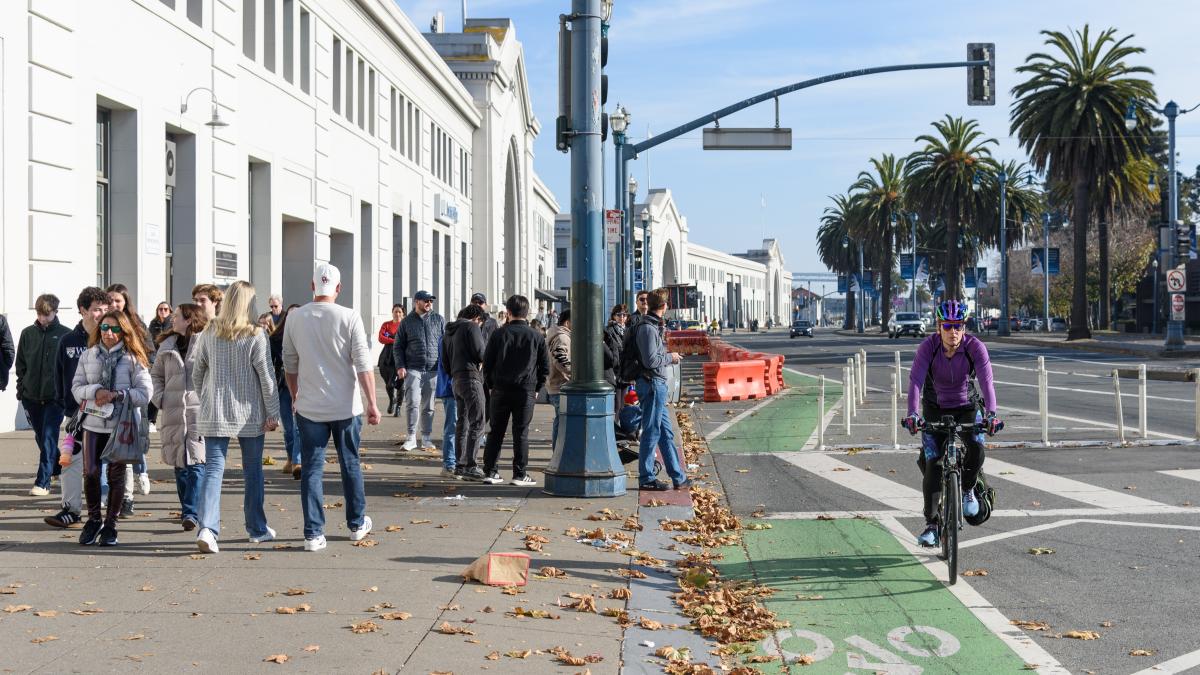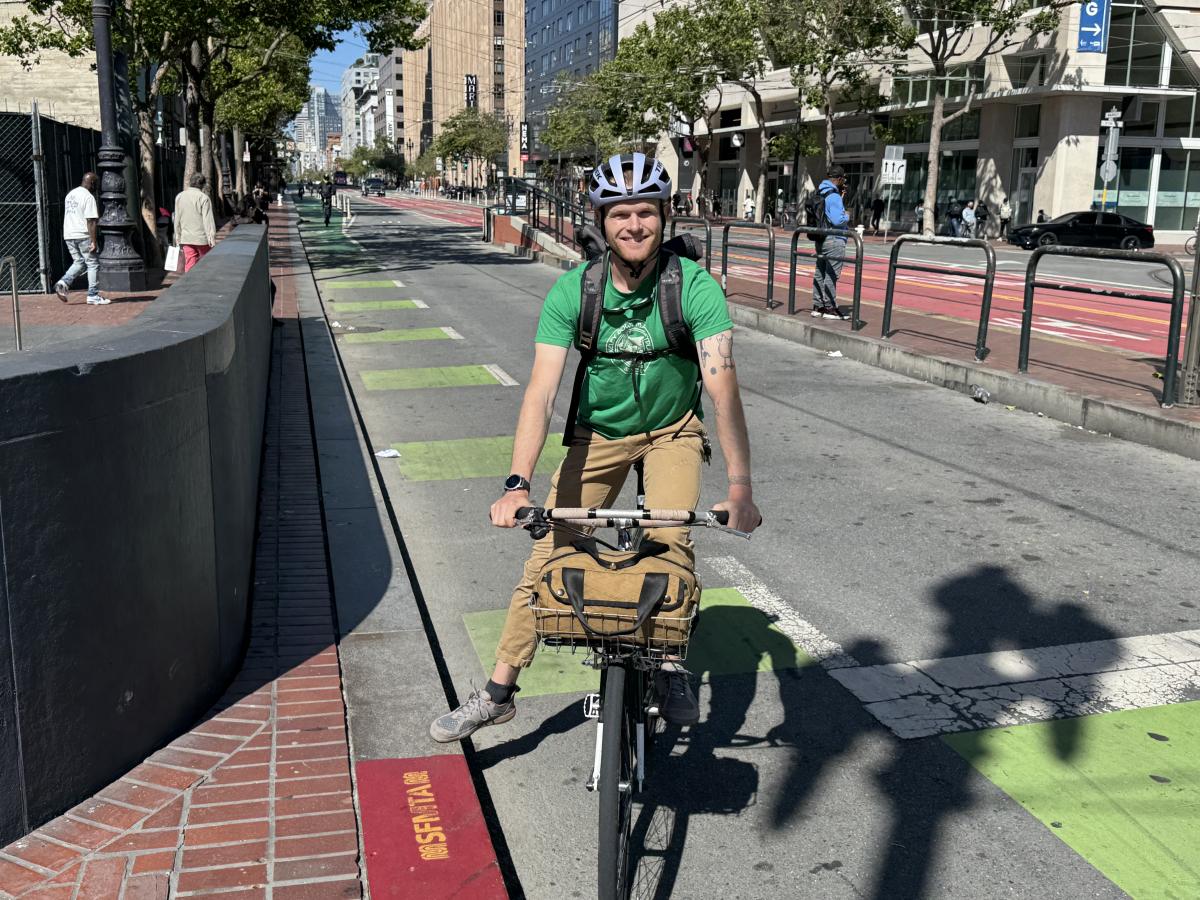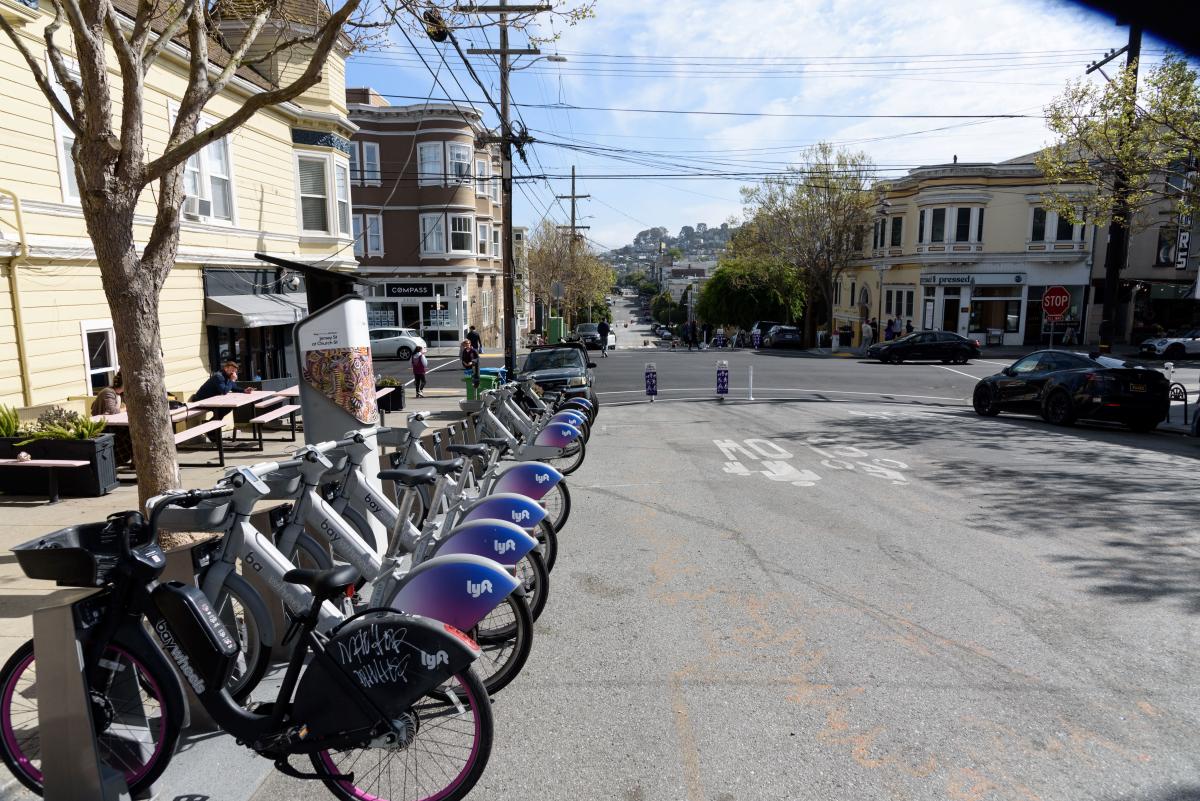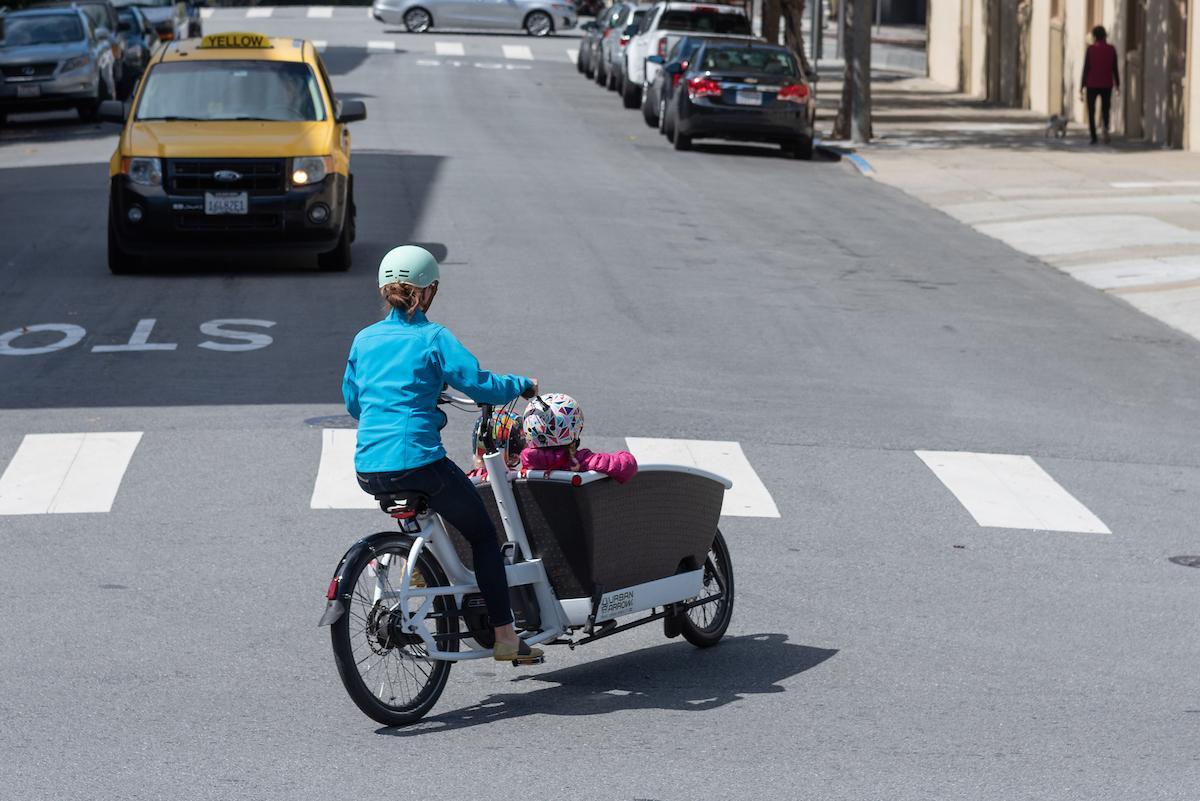
Members of our SFMTA bike-commute panel: From left, Julia Friedlander, Michael Rhodes and Jack Anninos (not pictured: Elliot Goodrich, Christy Osorio and Miriam Sorell).
Between our typically mild weather and expansive bicycle network, San Francisco is pretty much ideal for bike commuting. And indeed, the city has among the highest percentage of bike commuters in the U.S.
We’ve done a lot of work to make San Francisco more bike friendly. We have a 400-mile bike network that includes more than 130 miles of dedicated bike lanes, 87 miles of off-street paths and 51 miles of bike lanes that are fully separated from car traffic.
We’ve heard that even more people would consider biking to work but haven’t taken the plunge. San Francisco is a famously hilly city, and one with narrow roads that can be congested with traffic, particularly during rush hours. But these shouldn’t be obstacles to getting to work (and getting in a workout) on your bike.
We asked six SFMTA employees, all committed bike commuters, for their tips for the bike-commute curious.

Bike commuters can take advantage of our 400-mile bike network.
Jack Anninos, Assistant Traffic Engineer
Jack has been bike-commuting to work for about 10 years, both here and in Atlanta, where he lived previously. He’s been doing this commute for five years. He rides into the office at least three times per week.
Bike? Jack rides a fixie [a single-speed bike].
Route? Jack starts his trip in North Beach and heads down Stockton Street. Jack goes through the Stockton Tunnel and Union Square, before hitting Market Street and cruising to our office at 1 South Van Ness.
“On the way back, I take Market to Grant,” Jack said. “It’s hillier and I love seeing what’s going on in Chinatown every day. And I grab a slice of pizza on my way home.”
Tips for the bike-commute curious?
- Map out your route and try it for the first time on a weekend. Pick the best and safest route, even if it’s a little longer. “Don’t race people. Enjoy it. Have it be a great part of your day and not a bore,” he said.
- Go at an easy pace, so you don’t get too sweaty, especially if your workplace doesn’t have a shower.
- Before you start commuting, take your bike to a bike shop and make sure it’s in good repair.
Julia Friedlander, Senior Manager for Automated Driving Policy
Julia became a regular bike commuter during the pandemic. She had tried to bike commute several times earlier, but the demands of combining school and work trips were too much before the days of e-cargo bikes.
Bike? Julia was lucky to inherit an e-bike from a friend.
Route? Julia said her commute starts with the multi-use trail in the Panhandle, and she takes advantage of the Page Street Slow Street. “I look for as many car-light options as possible.”
Why ride to work? “I ride to work for three key reasons,” Julia said. “First, it keeps me fit and healthy for a very low cost. I don’t need to go a gym,” she said. “It’s instant endorphins and makes me really happy at the beginning and end of my work day. And I feel good about living lightly on the earth.”
Tips for the bike-commute curious:
- Set a very reasonable goal. Don’t decide to do it like a New Year’s resolution and decide to ride to work for a month. Set a goal, like five times in a summer, or once a week. Make it reasonable so you give yourself room to exceed expectations.
- Ask advice from people you know who ride bikes but who do not necessarily identify as “cyclists.”
- Give yourself time to plan for success. Plan for a route that you feel safe on and map it out in a car or on the bus. Plan for what clothes will make you feel comfortable riding and figure out how to carry things on the bike.
- Practice when you don’t have time pressure, maybe on the weekend or maybe leave a little bit earlier.
Elliot Goodrich, Transportation Planner
Elliot has been bike commuting since he was 14, starting with riding his bike to high school, then to college and for all of the jobs he’s had since he graduated a little more than a decade ago.
Bike? Elliot rides a steel commuter bike with a basket. “So I can carry a change of clothes and my lunch and stuff,” he said.
Route? Elliot has the longest commute of any of our panelists, riding in from Oakland’s Grand Lake neighborhood. He rides his bike to BART or he takes the Caltrans Bike Shuttle across the Bay Bridge. He either rides his bike from the Civic Center BART station or from the Embarcadero to the office.
Why ride to work? Elliot prizes the flexibility a bike commute offers. “If I want to go to happy hour or meet up with friends after work, I can, and I can get to places in the city very easily,” he said. He also likes the possibility of getting some after-work exercise. “Occasionally, I ride my bike all the way home over the Golden Gate, Richmond and San Rafael bridges. It’s about 40 miles, and it takes me two-and-a-half hours, but it’s gorgeous,” Elliot said.
Tips for the bike-commute curious:
- Try different routes and combinations of modes to see what feels best for you.
- Take an Urban Cycling 101 class. Many different organizations in the Bay Area offer instructions. “Just like learning to drive a car, having formal instruction can give you more understanding of bike strategies and how to handle traffic.”

Elliot commuting down Market Street.
Christy Osorio, Transportation Planner
Christy has been bike commuting for about 19 years and rides in at least three times a week.
Bike? Christy rides a 1990 Schwinn 12-speed commuter bike, which she recently had repainted.
Route? Christy rides to work through SoMa. She takes Howard Street to work and heads home on Folsom Street.
Why ride to work? The number one reason Christy started bike commuting is because she had a terrible time finding parking at her job 19 years ago. As she got used to bike commuting, Christy got more confident and started seeing the benefits of riding in and said it improved her mood. “Now I ride in because it’s a nice way to start the day. It’s a personal preference.”
Tips for the bike-commute curious:
- Take your time. Don’t feel the need to rush through a yellow light; just wait for it to change. Be safe.
- Carry a patch kit and locks. If you don’t feel like fixing your own flats, know where bike shops are near work and drop your bike off at lunch.
- Communicate with other riders. If you’re passing another rider, make sure they know you’re coming. “I love communicating with other riders,” Christy said. “It’s a benefit of not being in a car. We can talk to each other. I always say ‘On your left!’ when I’m passing other bikers.”
- Look into the sideview mirrors of parked cars to see if there’s someone inside. That way, you can anticipate an opening car door. “It’s about spatial awareness.”
Michael Rhodes, Transit Priority Manager
Michael has been a bike commuter on and off for 15 years, but he’s been a regular commuter for the last year. He typically rides into work three times a week.
Bike? Michael rides an e-bike.
Route? Michael starts his trip in the Inner Richmond, where he enters Golden Gate Park. He drops one of his kids off at school and then continues to Waller Street, where he drops off another kid. He then hits the Page Street Slow Street and makes his way down Market Street to the office.
Why ride to work? Michael started bike commuting regularly because it’s a fast, convenient and affordable way to get to work. It also allows him to drop his kids off at their school and day care facilities without having to return home, as he would have to if he did the drop-offs by car. Biking cuts his morning commute, including the drop-offs, from an hour to 25 minutes. “It’s not just a fun and sustainable way to get around, but it’s very practical for trips that aren’t convenient by other modes [of transportation],” Michael said.
Tips for the bike-commute curious:
- Talk to someone who knows the city’s bike network before you start. That can help you identify a route that works. Better still, find a buddy! Biking is a social activity, and it’s best with someone who knows the ropes.
- “Bike commuting has saved me a ton of time and has been a huge game changer,” Michael said. It’s worth trying!

The Baywheels bike share system is a great way to try bike commuting and to test out an e-bike.
Miriam Sorell, Transit Operations Performance Officer
Miriam has bike-commuted on and off for about 15 years, but she has been a regular e-bike commuter since 2019, when her first child was a year old.
Bike? Miriam has a cargo e-bike with two kid seats, but she primarily uses the Baywheels bikeshare system.
Route? Miriam starts in the Lower Haight and rides on Page Street to Market Street after dropping off her kids, or she takes the Duboce Bike Path when coming straight from home. She usually rides into the office two days a week.
Why ride to work? During the summer Miriam, like Michael, uses her e-bike to drop her kids off at camp. She finds it easier to manage children on an e-bike than rushing to catch the bus. Plus, the distances are a little too long for her kids to walk. School is so close to home that she and her kids walk there, but she loves the flexibility of being able to hop on a Baywheels bike for the rest of her trip to work.
Tips for the bike-commute curious:
- Do your first ride with someone or find a bike buddy. There are a lot of nuances in the city’s bike network that may not be apparent on mapping apps.
- Err on the side of taking up too much space and ride where you feel more comfortable. That may mean edging out of the bike lane to avoid cars’ door zones.
- Never pass a big vehicle on the right side. Look around and assume drivers are not paying attention.
- Try out Baywheels! That way, you don’t have to commit to buying a bike, and you can ride it for part of your route and combine biking with riding Muni or walking. That’s especially handy if your route is long or includes stretches that may be uncomfortable to bike.

Muni buses have space for two bikes on their racks, a good option if the hills are too steep.
And what about those hills?
Half our panel swears by e-bikes. They’re a useful tool for navigating the city’s famous hills. They can be a big investment, Julia noted, but it’s possible to try one out before committing.
Many local bike shops rent e-bikes to try out, and they’re available for a reasonable fee through the Baywheels bikeshare program. “We have amazing biking weather and challenging biking topography,” Michael said. “Having an e-bike can flatten those hills out.”
Another way to flatten San Francisco’s hills sound basic, but it isn’t: Just avoid them. Our panel recommends talking to other bike commuters, bike organizations or even local bike shops to find ways — like “The Wiggle” — around the hills.
“Pick your route not based on the shortest way but on the least elevation gain,” Jack said. “And if you get tired, every Muni bus has space for two bikes on its rack, so you can always bail,” Elliot added.
Or you can simply walk your bike up the most challenging hills. “I live on a hill and I’ve never ridden up it,” Christy said.

An e-bike can help flatten San Francisco’s hills and is a great way to transport children!
How to get started
Our bike education webpage includes links to local organizations, like the San Francisco Bicycle Coalition, that offer bike-education and bike-commute classes. If you want to try out an e-bike, check out the Bay Wheels bikeshare system. We have more than 330 bikeshare stations.
To see all the ways we're encouraging biking, check out our new bike fact sheet. And don't worry about parking -- there are 9,000 parking spots at bike racks citywide.
Happy riding!
Comments are for the English version of this page.